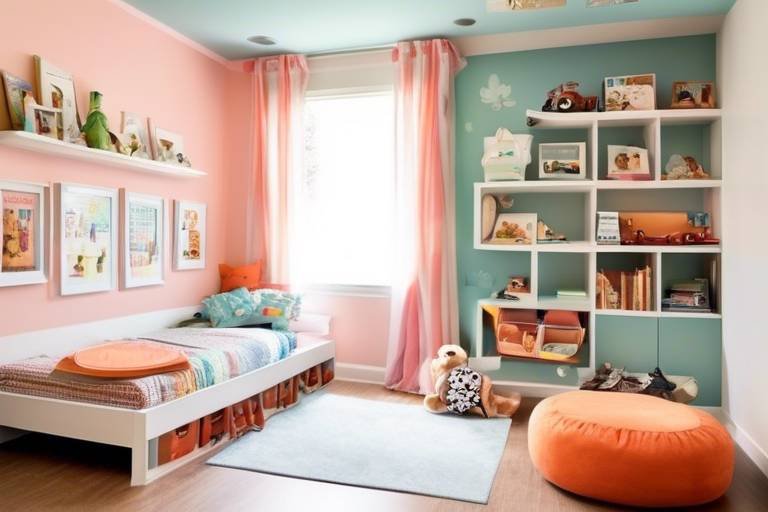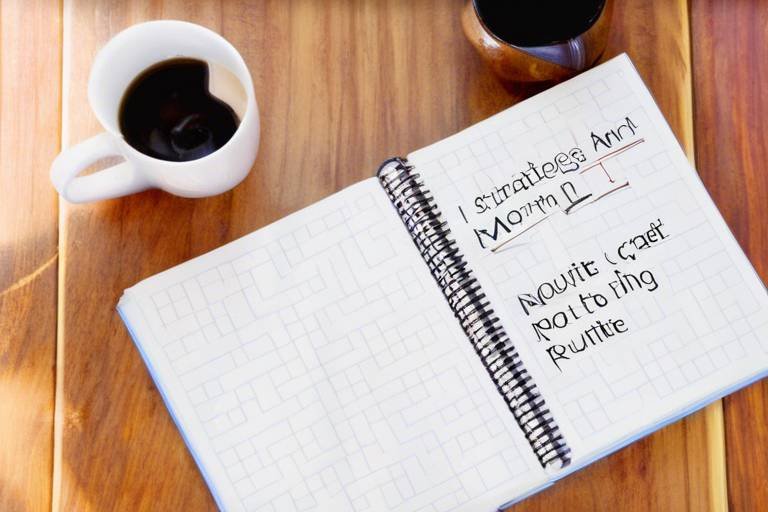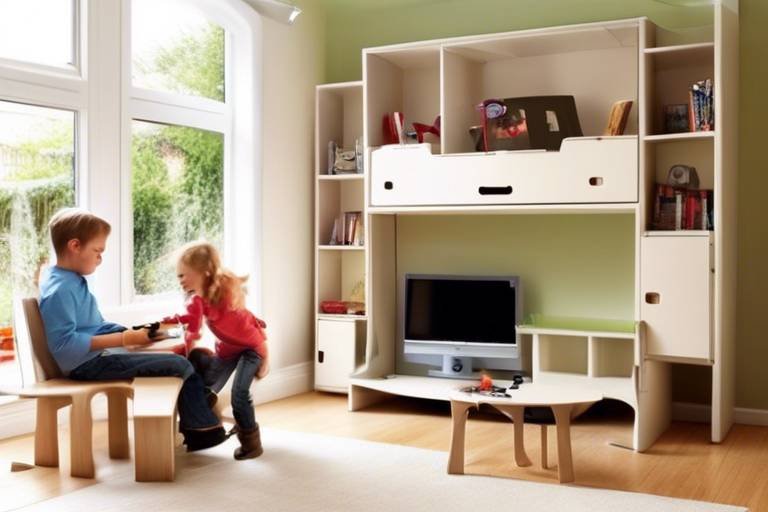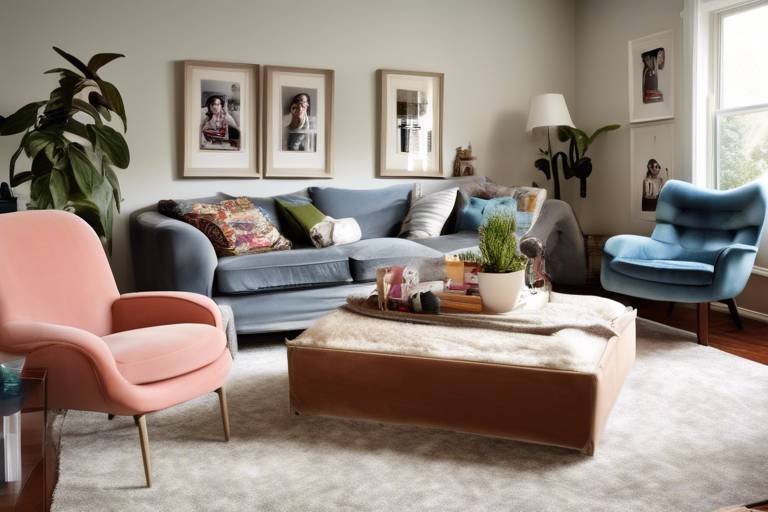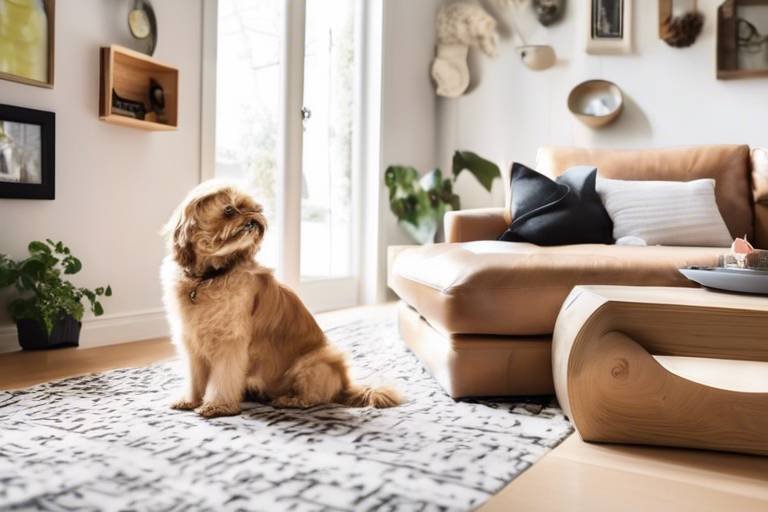Designing a Functional Home Office for Parents
Creating a home office that caters to the unique needs of parents can feel like a daunting task, but with the right approach, it can also be incredibly rewarding. As parents, you're not just juggling work responsibilities; you're also managing family life, which means your workspace must be both functional and adaptable. Imagine walking into a space that not only inspires productivity but also feels welcoming and comfortable. This is the essence of designing a functional home office for parents.
First and foremost, it's essential to recognize that your home office should be a reflection of your personal style while also serving a practical purpose. Think of it as your own little sanctuary where creativity meets organization. You want a space that allows you to dive into work but also feels like a place where you can unwind during breaks. Achieving this balance is key to maintaining your sanity while working from home.
One of the most significant aspects to consider is how you can optimize your workspace to minimize distractions. This can be particularly challenging in a busy household, where the hustle and bustle of family life can easily seep into your work time. To combat this, think about incorporating elements that help create a focused environment. For instance, using noise-canceling headphones can help block out background noise, while a dedicated workspace can signal to your family that you’re in “work mode.”
Additionally, don't underestimate the importance of natural light. A well-lit space can dramatically improve your mood and productivity. Position your desk near a window if possible, and consider using soft, warm lighting to create a cozy atmosphere. You might also want to add some plants to your office; not only do they enhance the aesthetic appeal, but they also purify the air, promoting a healthier workspace.
Now, let’s talk about organization. A cluttered desk can lead to a cluttered mind, and as a parent, you need every mental edge you can get. Invest in storage solutions that keep your workspace tidy. This could range from stylish file organizers to wall-mounted shelves that free up desk space. By creating a system that works for you, you'll find it easier to focus on the tasks at hand without the distraction of disorganization.
Moreover, setting boundaries with family members is crucial. This isn't just about having a designated workspace; it's about communicating your needs effectively. Establishing clear work hours can help your family understand when you’re available for family activities and when you need to concentrate on work. It’s all about creating a respectful environment where everyone’s needs are acknowledged.
As you design your home office, remember to incorporate technology that enhances your workflow. From reliable Wi-Fi to collaboration tools, having the right tech can make a world of difference in how you manage your work-life balance. Consider software that helps streamline tasks or apps that keep you organized. The right tools can transform your home office into a powerhouse of productivity.
Finally, personalizing your workspace can be a game-changer. Surrounding yourself with items that inspire you—like photos, artwork, or motivational quotes—can boost your spirits and creativity. Just remember to keep it professional; it’s a delicate balance between making the space your own and ensuring it remains conducive to work.
In conclusion, designing a functional home office for parents is about creating a space that fosters productivity while being adaptable to family life. By considering factors like location, organization, technology, and personalization, you can craft an environment that not only meets your work needs but also enhances your overall well-being. So roll up your sleeves, get creative, and transform your home office into a space where you can thrive both as a professional and a parent.
- What are the best locations for a home office?
Consider quiet areas away from high-traffic zones, with ample natural light and minimal distractions.
- How can I make my home office more ergonomic?
Invest in adjustable chairs and desks, ensuring your monitor is at eye level to promote good posture.
- What technology is essential for a home office?
Reliable internet, a good computer, and collaboration tools like Zoom or Slack can greatly enhance your productivity.
- How do I establish boundaries with my family?
Communicate your work hours clearly and create a physical barrier, like a door or a designated area, to signal when you are working.

Choosing the Right Location
When it comes to setting up your home office, is absolutely crucial. Imagine trying to concentrate on a project while your kids are running around, or the television is blaring in the background. It's like trying to read a book in a crowded café – not exactly the ideal environment for productivity! So, how do you find that perfect spot? Start by considering factors like noise levels, natural light, and the proximity to family activities.
First off, let’s talk about noise. If you have little ones at home, you know how quickly things can get chaotic. Try to find a space that’s somewhat isolated from the hustle and bustle of daily family life. A spare room, a corner of the living room, or even a well-placed partition can work wonders. You might even want to consider soundproofing options if you're serious about minimizing distractions.
Next, let’s shine a light on natural light. Did you know that working in bright, well-lit spaces can boost your mood and productivity? Position your desk near a window if possible. Not only will you enjoy the benefits of daylight, but you’ll also have a lovely view to gaze at during those long work hours. However, be cautious of glare on your computer screen; you want the light to work for you, not against you. If natural light isn’t an option, invest in good quality lighting that mimics daylight to keep your workspace inviting.
Now, consider the proximity to family activities. While you want to create a space that allows you to focus, you also don’t want to feel completely cut off from your family. If you can, choose a location where you can keep an ear out for the kids while still maintaining your concentration. This might mean setting up in a den or a home office that opens up into the main living area. This way, you can stay connected to family life while being productive.
Lastly, don’t forget to personalize your space. Once you’ve found the right location, make it your own! Add some personal touches like family photos, inspiring quotes, or plants to create an atmosphere that feels comfortable and motivating. A workspace that reflects your personality can make a world of difference in how you feel about working from home.
In summary, choosing the right location for your home office is about striking a balance between minimizing distractions and maximizing comfort. Remember to consider noise levels, natural light, and your connection to family activities. With the right space, you can create a productive environment that supports both your work and family life.

Ergonomic Furniture Selection
When it comes to creating a home office that supports your productivity, ergonomic furniture is a game-changer. Imagine spending hours hunched over a desk, only to find yourself with a sore back and stiff neck by the end of the day. Not exactly the ideal work scenario, right? Investing in ergonomic furniture is not just about comfort; it's about enhancing your overall work performance and ensuring your well-being while you juggle work and family responsibilities.
First off, let's talk about chairs. A good ergonomic chair should provide adequate lumbar support to keep your spine in its natural curve. Look for chairs that allow you to adjust the height, armrests, and backrest to fit your body perfectly. This way, you can maintain a posture that reduces strain during those long hours of work. Consider features like breathable fabric and cushioning that can make a world of difference. After all, a comfortable chair is like a trusty sidekick—always there to support you through thick and thin.
Next, we have desks. The height of your desk is crucial for maintaining a healthy posture. A desk that’s too high or too low can lead to discomfort and decreased productivity. Ideally, your elbows should be at a 90-degree angle while typing, and your feet should rest flat on the floor. If you're feeling adventurous, you might even explore standing desks or adjustable desks that allow you to switch between sitting and standing throughout the day. This not only helps in reducing fatigue but also keeps your energy levels up. Think of it as giving your body a little workout while you work!
To give you a clearer picture, here’s a simple comparison of different ergonomic chair features you might want to consider:
| Feature | Benefits |
|---|---|
| Lumbar Support | Reduces lower back pain and promotes good posture. |
| Adjustable Height | Ensures proper alignment with your desk for optimal comfort. |
| Breathable Fabric | Keeps you cool and comfortable during long working hours. |
| Armrests | Provides support for your arms, reducing shoulder strain. |
In addition to chairs and desks, consider other ergonomic accessories like keyboard trays and mouse pads with wrist support. These small additions can have a significant impact on your comfort level. The goal is to create a workspace that feels like a second home, where you can dive into your tasks without the nagging discomfort that often comes with long hours of work.
Lastly, remember that everyone’s body is different. What works for one person may not work for another. Take the time to test out different options and find what suits you best. After all, the right ergonomic furniture not only boosts your productivity but also shows that you care about your health and well-being. So go ahead, invest in your comfort—you deserve it!
- What is ergonomic furniture? Ergonomic furniture is designed to support the body’s natural posture and reduce strain during prolonged use.
- Why is ergonomic furniture important for home offices? It helps prevent discomfort and injuries associated with long hours of sitting, leading to better productivity and overall health.
- How can I choose the right ergonomic chair? Look for features like lumbar support, adjustable height, and breathable material to ensure comfort and support.
- Are standing desks beneficial? Yes, standing desks can help reduce fatigue and promote better posture by allowing you to alternate between sitting and standing.

Effective Organization Strategies
When it comes to creating a productive home office, effective organization strategies can make all the difference. Think of your workspace as a well-oiled machine; every component needs to be in its right place for optimal performance. You wouldn't want to work in a cluttered environment, right? It's like trying to find a needle in a haystack! So, let’s dive into some practical tips that can help transform your chaotic workspace into a sanctuary of productivity.
First off, consider implementing a filing system. Whether you prefer digital or physical files, having a clear method for organizing documents is essential. For example, you could categorize your files by project, client, or even by urgency. A simple table can help you visualize your filing system:
| Category | Examples | Storage Method |
|---|---|---|
| Projects | Project A, Project B | Digital Folders |
| Clients | Client X, Client Y | Physical Files |
| Urgency | High, Medium, Low | Color-Coded Binders |
Next, let’s talk about storage solutions. Utilize vertical space by installing shelves or cabinets that can house books, supplies, and other materials. This not only keeps your desk clear but also makes it easier to find what you need quickly. You might also want to consider using storage boxes or bins to group similar items together. For instance, keep all your stationery in one box and your tech gadgets in another. This way, when you need something, you won't have to dig through a pile of unrelated items.
Another effective strategy is to leverage digital tools for organization. Applications like Trello, Asana, or even Google Drive can help you keep track of tasks and deadlines. Imagine having a digital dashboard where you can see everything at a glance! This not only helps in managing your workload but also minimizes the stress of forgetting important tasks.
Furthermore, don't underestimate the power of a good clean-up routine. Schedule a few minutes at the end of each day to tidy up your workspace. This could involve putting away loose papers, wiping down surfaces, or even rearranging items that have become disorganized throughout the day. By making this a habit, you’ll start each day with a fresh slate, ready to tackle whatever comes your way!
Lastly, consider using visual aids to keep yourself motivated and organized. A whiteboard or a corkboard can serve as a great reminder of your goals and deadlines. You can jot down important tasks, inspirational quotes, or even a visual representation of your progress. It’s like having a personal cheerleader right in your office!
In conclusion, effective organization strategies are not just about keeping your physical space tidy; they are about creating an environment that fosters productivity and creativity. By implementing these tips, you’ll find that balancing work and family life becomes a lot easier. Remember, a well-organized workspace is the first step towards a successful work-from-home experience!
- What is the best way to organize a home office? The best way to organize a home office is to create a systematic filing system, utilize vertical space for storage, and leverage digital tools to keep track of tasks.
- How often should I clean my home office? It's a good idea to clean your home office daily, taking a few minutes at the end of each workday to tidy up and prepare for the next day.
- What tools can help with organization? Tools like Trello, Asana, and Google Drive are excellent for keeping track of tasks and deadlines, while physical storage solutions like shelves and bins can help keep your workspace tidy.

Setting Boundaries with Family
When you're working from home as a parent, setting boundaries with your family can feel like walking a tightrope. It's a delicate balance between being present for your loved ones and ensuring that you can complete your work tasks efficiently. So, how do you create a productive work environment while still being an engaged parent? The answer lies in clear communication and establishing guidelines that everyone can respect.
First and foremost, it's essential to have an open conversation with your family about your work hours. Let them know when you're available and when you need uninterrupted time. You might say something like, "Hey family, from 9 AM to 12 PM, I'll be working on important projects, so I need you to help keep the noise down." This not only sets expectations but also teaches your family that work time is important, just like any other job.
Another effective strategy is to create a physical boundary that signals when you're in work mode. This could be as simple as closing a door, using a designated workspace, or even wearing specific headphones. When you put on those headphones, it's a signal that you're focusing on work, not family activities. You can also establish a visual cue, such as a sign on your office door that says, "In Session - Please Do Not Disturb." This way, family members know when it's appropriate to approach you and when to give you space.
It’s also helpful to implement a “family check-in” system. Schedule short breaks during your work hours where you can reconnect with your family. For instance, you could take a 10-minute break every hour to catch up, grab a snack together, or even share a quick laugh. This not only allows you to stay connected but also gives your family something to look forward to, making them more likely to respect your work hours.
Additionally, consider creating a family calendar that includes your work schedule. This way, everyone in the household can see when you are busy and when you are free. You could use a shared digital calendar or a physical one placed in a common area. This transparency helps in minimizing interruptions during your work hours and encourages your family to plan their activities accordingly.
Lastly, remember that flexibility is key. There will be days when things don’t go as planned, and that’s perfectly okay. Being a parent means adapting to the unexpected, so be prepared to adjust your boundaries when necessary. Just ensure that you communicate any changes to your family so they understand the shift in your schedule.
In summary, setting boundaries with family while working from home requires a mix of clear communication, physical signals, and flexibility. By establishing these boundaries, you'll not only enhance your productivity but also foster a respectful environment where both your work and family life can thrive.
- How can I communicate my work schedule effectively to my family? Start by having a family meeting to discuss your work hours and why they are important. Use clear language and encourage questions.
- What if my family doesn't respect my boundaries? If boundaries are being crossed, calmly remind them of your agreed-upon schedule and reinforce the importance of uninterrupted work time.
- Can I be flexible with my work schedule? Yes! Flexibility is essential, but ensure that any changes are communicated clearly to your family to avoid confusion.
- What are some signs that I need to adjust my boundaries? If you find yourself frequently distracted or unable to focus, it may be time to reassess and strengthen your boundaries.

Incorporating Technology
In today's fast-paced world, into your home office is not just a luxury; it's a necessity. Imagine working from a space that is not only comfortable but also equipped with the latest tools that enhance your productivity and streamline your tasks. Whether you're juggling video calls, managing projects, or collaborating with colleagues, the right technology can make all the difference. So, what should you consider when setting up your tech-savvy workspace?
First off, investing in a reliable high-speed internet connection is crucial. Nothing is more frustrating than a lagging connection during an important meeting. Additionally, consider using a dual-monitor setup. This allows you to have multiple applications open simultaneously, making multitasking a breeze. For instance, you can have your video call on one screen while taking notes or working on documents on the other. It's like having an extra pair of hands!
Next, think about the software tools that can enhance your workflow. Applications like Slack and Trello can significantly improve communication and project management, especially when you're working with a remote team. These platforms allow you to stay organized and keep everyone on the same page, which is essential when balancing work and family life.
Moreover, don't underestimate the power of cloud storage solutions. Services like Google Drive or Dropbox can help you access your files from anywhere, ensuring you can work seamlessly, whether you're at home or on the go. This flexibility is particularly beneficial for parents who may need to shift between different environments throughout the day.
Lastly, consider investing in smart home devices. These can help automate tasks and create a more efficient work environment. For instance, smart speakers can set reminders, play music to boost your mood, or even control your lighting—all with simple voice commands. This not only saves time but also allows you to focus more on your work rather than getting bogged down by mundane tasks.
In summary, incorporating technology into your home office is about creating a space that works for you. By selecting the right tools and software, you can enhance your productivity and make your work-life balance much more manageable. The right tech can transform your workspace into a hub of efficiency, allowing you to thrive both professionally and personally.
- What are the essential tech gadgets for a home office?
Essential gadgets include a reliable laptop, dual monitors, a good quality webcam, noise-canceling headphones, and a printer. - How can I improve my internet connection for remote work?
Consider upgrading your internet plan, using a wired connection, or investing in a Wi-Fi extender to boost your signal. - What software tools are best for remote collaboration?
Tools like Zoom for video conferencing, Slack for messaging, and Trello for project management are highly recommended.

Creating a Distraction-Free Environment
In the hustle and bustle of family life, creating a distraction-free environment for your home office can feel like trying to find a needle in a haystack. But fear not! With the right strategies, you can carve out a space that allows you to focus and work efficiently, even amidst the chaos of daily family activities. First and foremost, consider the location of your workspace. Ideally, it should be situated away from high-traffic areas where noise and interruptions are likely to occur. A quiet corner of your home, perhaps a spare room or a nook away from the living room, can work wonders for your concentration.
Next, let’s talk about the power of sound. Sometimes, the silence can be deafening, especially when you’re trying to concentrate. Consider using white noise machines or playing soft background music. This can help drown out distracting noises and create a soothing atmosphere that encourages productivity. If you’re not a fan of music, you might also explore podcasts or audiobooks that can engage your mind without pulling your attention away from your work.
Another vital aspect of creating a distraction-free environment is to establish physical boundaries. Make it clear to your family when you are in “work mode.” You could use a simple sign on your door or a designated workspace that signals to others that you are unavailable for chats or interruptions. This not only helps in minimizing disturbances but also sets a precedent for your children or family members about respecting your work time.
Moreover, decluttering your workspace can significantly enhance your focus. A tidy environment is often associated with a clear mind. Take a moment to organize your desk, removing any items that are not essential for your work. You might even consider using storage solutions like
| Type of Storage | Benefits |
|---|---|
| File Cabinets | Keep documents organized and out of sight. |
| Drawer Organizers | Help keep office supplies neatly arranged. |
| Wall Shelves | Maximize vertical space and reduce clutter. |
In addition to physical organization, it's crucial to manage your digital distractions. Have you ever found yourself scrolling through social media when you should be working? It’s all too easy to get sidetracked. To combat this, consider using website blockers during your work hours. These tools can help you stay focused by temporarily restricting access to distracting sites, allowing you to concentrate on your tasks without the temptation of checking your notifications.
Lastly, remember that a distraction-free environment is not just about eliminating interruptions; it’s also about creating an inspiring space. Personal touches, such as motivational quotes or a vision board, can serve as a gentle reminder of your goals and aspirations, keeping you motivated throughout the day. So, while you focus on minimizing distractions, don’t forget to infuse your workspace with elements that inspire you.
In conclusion, creating a distraction-free environment in your home office requires a combination of strategic location, sound management, physical and digital organization, and personal inspiration. By implementing these tips, you can transform your workspace into a haven of productivity, allowing you to balance your work and family life more effectively.
- How can I minimize noise distractions in my home office? Consider using noise-canceling headphones or playing white noise to help drown out background sounds.
- What are some effective ways to communicate my work hours to my family? Use visual cues like a sign on your door or set specific hours when you are not to be disturbed.
- How important is organization for maintaining focus? A well-organized workspace reduces clutter and distractions, allowing for better concentration and productivity.
- Can personal items in my workspace be distracting? While personal items can inspire, be mindful to keep only those that motivate you, avoiding clutter that may divert your attention.

Personalizing Your Space
When it comes to creating a home office that truly reflects who you are, personalization is key. Think of your workspace as a blank canvas waiting for your unique brush strokes. It’s not just about functionality; it’s about infusing your personality into the space to make it feel like your own little sanctuary amidst the chaos of family life. How can you achieve this? Let’s dive in!
First off, consider the color scheme. Colors can significantly affect your mood and productivity levels. For instance, calming blues and greens can create a serene environment, while vibrant yellows and oranges might inspire creativity and energy. You might even want to paint one wall a bold color or use colorful accessories like cushions or art to brighten the space. It’s all about what resonates with you and encourages you to get in the zone.
Next, think about incorporating personal items into your workspace. This could be anything from family photos to your favorite books or souvenirs from memorable trips. These items can serve as motivating reminders of your goals and achievements. For instance, placing a framed photo of a family vacation on your desk can offer a quick mental escape during a stressful workday.
Another fantastic way to personalize your office is through artwork. Whether it’s a piece created by your child or a print from your favorite artist, having art around can spark joy and creativity. Consider creating a gallery wall that showcases your taste and interests. It’s a simple yet effective way to transform a bland space into a vibrant one.
Don’t forget about functionality in your personalization efforts. While it’s essential to make your space visually appealing, it should also cater to your work needs. For example, if you love to write, consider adding a comfortable chair and a small bookshelf filled with your favorite writing resources. This way, your workspace not only reflects your personality but also enhances your productivity.
Lastly, let’s talk about plants. Bringing a bit of nature indoors can do wonders for your mood and air quality. Choose low-maintenance plants like succulents or pothos if you’re not a green thumb. Not only do they add a splash of color, but they also create a calming atmosphere that can help you focus better.
In summary, personalizing your home office is about creating a space that inspires you and reflects your personality. By considering elements like color, personal items, artwork, functionality, and plants, you can transform your workspace into a haven that keeps you motivated and productive. So go ahead, let your creativity flow, and make that office truly yours!
- Why is personalizing my home office important? Personalizing your workspace can enhance your motivation, creativity, and overall productivity. It makes the space feel more comfortable and inviting.
- What are some easy ways to personalize my office? You can personalize your office by adding photos, artwork, choosing a color scheme you love, and incorporating plants.
- How can I balance personalization with functionality? Choose items that serve a dual purpose, such as decorative storage solutions or a stylish desk organizer that matches your aesthetic.

Balancing Work and Family Life
Finding the right balance between work and family can often feel like walking a tightrope. As a parent, the demands of your job can sometimes clash with the needs of your family, creating a whirlwind of stress and chaos. So, how can you juggle these two important aspects of your life without feeling overwhelmed? The answer lies in effective time management and setting realistic expectations.
First and foremost, it's crucial to prioritize your tasks. Start each day by identifying what absolutely needs to get done, both at work and at home. You might find it helpful to create a list that separates your work responsibilities from your family obligations. This way, you can visually see where your time needs to be allocated. For instance:
| Work Tasks | Family Tasks |
|---|---|
| Complete project report | Help kids with homework |
| Attend virtual meeting | Prepare dinner |
| Respond to emails | Spend quality time with family |
Once you have your tasks laid out, consider establishing a structured schedule. This doesn’t mean you have to stick to a rigid timetable, but having a rough outline of your day can help you allocate time for both work and family. For example, you might decide to dedicate the early morning hours to uninterrupted work before the kids wake up. This way, you can tackle your most challenging tasks when your mind is fresh and free from distractions.
Another vital aspect of balancing work and family life is communication. Make sure to discuss your work schedule with your family. Let them know when you’ll be available and when you need focused time. This not only sets clear expectations but also fosters an environment of respect. You can even involve your family in creating a visual schedule that everyone can see, helping them understand when you need quiet time.
It's also important to recognize that flexibility is key. Life with kids is unpredictable, and sometimes you may need to shift priorities. Be prepared to adapt your schedule when unexpected events occur, whether it’s a sick child or a last-minute work deadline. Embrace the chaos and remind yourself that it’s okay to adjust your plans as needed.
Finally, don’t forget to carve out quality time for yourself. Balancing work and family can be exhausting, so it’s essential to recharge your batteries. Whether it’s dedicating an hour to a hobby, exercising, or simply enjoying a quiet cup of coffee, self-care plays a significant role in maintaining your overall well-being. When you take care of yourself, you’ll be better equipped to handle the demands of both work and family life.
- How can I manage my time effectively while working from home? Start by prioritizing tasks, creating a structured schedule, and communicating your availability with your family.
- What are some tips for setting boundaries with family members? Clearly communicate your work hours, involve them in creating a visual schedule, and be firm yet flexible when interruptions occur.
- How important is self-care in balancing work and family? Self-care is crucial; it helps you recharge and maintain a healthy balance between your responsibilities.

Establishing a Routine
Creating a consistent routine is like setting the foundation for a sturdy house; without it, everything can feel a bit shaky. For parents juggling work and family life, establishing a routine is essential not just for productivity, but for maintaining sanity amidst the chaos. Imagine waking up each day with a clear plan, knowing exactly when to dive into work and when to switch gears to family mode. Sounds dreamy, right? Let’s explore how you can craft a routine that works for you and your family.
First and foremost, it’s important to recognize that flexibility is key. While having a structured schedule is beneficial, life with kids can be unpredictable. To effectively manage your day, consider incorporating both fixed and flexible elements into your routine. For instance, you might set specific hours for focused work, but allow for adjustments when family needs arise. This way, you’re not left feeling frustrated when plans change.
To help visualize your daily routine, you might find it useful to create a simple table that outlines your typical day. Here’s an example:
| Time | Activity |
|---|---|
| 7:00 AM - 8:00 AM | Morning routine (breakfast, get kids ready) |
| 8:00 AM - 12:00 PM | Focused work time |
| 12:00 PM - 1:00 PM | Lunch break with family |
| 1:00 PM - 4:00 PM | Afternoon work session |
| 4:00 PM - 5:00 PM | Family time / activities |
| 5:00 PM - 6:00 PM | Wrap up work and plan for the next day |
As you can see, this example includes both work and family time, allowing for a balanced approach. It’s important to remember that everyone’s routine will look different. Find what works best for you and your family, and don’t hesitate to adjust as needed.
Another effective strategy is to involve your children in the routine. This can help them understand when you are working and when you are available. You might say something like, “I’ll be working from 8 to 12, but after that, we can play together!” This not only sets clear expectations but also fosters a sense of teamwork within the family.
Lastly, be sure to carve out time for yourself within your routine. It’s easy to get caught up in the hustle and bustle of work and family obligations, but self-care is crucial. Whether it’s a quick workout, reading a book, or enjoying a cup of coffee in peace, make sure to prioritize moments that recharge your batteries.
In conclusion, establishing a routine is about finding a rhythm that works for you and your family. By combining structure with flexibility, involving your kids, and ensuring you have time for self-care, you can create a balanced approach that enhances productivity and family harmony. Remember, it’s not about perfection; it’s about progress. So, take a deep breath, grab your planner, and start crafting that ideal routine!
- How long does it take to establish a new routine? It can take anywhere from a few weeks to a couple of months to fully adjust to a new routine. Be patient with yourself!
- What if my kids disrupt my work time? Communicate your schedule clearly with your children and set boundaries. Consider using visual timers to help them understand when you are busy.
- Can I change my routine if it’s not working? Absolutely! Routines are meant to be flexible. Don’t hesitate to tweak your schedule based on what feels right for you and your family.
Frequently Asked Questions
- What is the best location for a home office?
Choosing the right location for your home office is key! Look for a spot that’s away from noisy areas, has plenty of natural light, and is close enough to family activities to keep you connected without too many distractions.
- How can I choose ergonomic furniture for my home office?
Investing in ergonomic furniture is super important for your comfort! When selecting chairs and desks, look for adjustable options that support good posture. Think of it like finding the perfect pair of shoes—comfort is essential for those long work hours!
- What are some effective organization strategies for a home office?
To keep your workspace tidy and efficient, consider using storage solutions like shelves, filing cabinets, and organizers. Think of your office as a puzzle; everything needs to fit just right for the best results!
- How can I set boundaries with my family while working from home?
Establishing clear boundaries is crucial! Communicate your work hours and let your family know when you can’t be disturbed. It’s like creating a 'do not disturb' sign for your time—everyone will appreciate the clarity!
- What technology should I incorporate into my home office?
Utilizing the right technology can really enhance your work experience! Consider tools like video conferencing software, project management apps, and cloud storage solutions to help you stay organized and connected while juggling family responsibilities.
- How can I create a distraction-free environment at home?
To minimize interruptions, set up a dedicated workspace and communicate your need for quiet time. Think of it as building a fortress of focus—surround yourself with an atmosphere that encourages productivity!
- How can I personalize my home office?
Personalizing your workspace can boost your motivation! Add personal touches like photos, artwork, or plants that reflect your style while keeping a professional vibe. It’s like adding your favorite flavor to a dish—just the right touch makes all the difference!
- What strategies can help me balance work and family life?
Finding balance is all about time management! Create a schedule that accommodates both work and family time. It’s like juggling—practice makes perfect, and soon you’ll find your rhythm!
- How can I establish a routine for productivity?
Creating a consistent routine can significantly reduce stress! Try to develop a daily schedule that works for you, ensuring you allocate time for both work and family. Think of it as setting the beat to your own life’s song—once you find it, everything flows smoothly!




